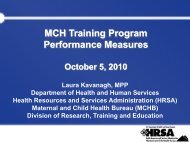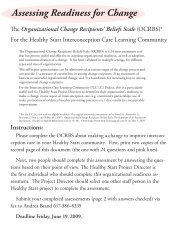Presentation Slides (pdf) - HRSA
Presentation Slides (pdf) - HRSA
Presentation Slides (pdf) - HRSA
You also want an ePaper? Increase the reach of your titles
YUMPU automatically turns print PDFs into web optimized ePapers that Google loves.
Emergency<br />
Severity Index<br />
for Pediatric Triage<br />
Anna Waller, ScD<br />
Debbie Travers, PhD, RN<br />
Jessica Katznelson, MD<br />
March 25, 2010<br />
Funded by Grant H34MC04371 from the Health Resource and Services Administration/<br />
Maternal and Child Health Bureau's Emergency Medical Services for Children Program .
Emergency<br />
Severity Index<br />
for Pediatric Triage<br />
Moderator:<br />
Jaclynn Haymon<br />
Program Manager, Children's National Medical Center<br />
Funded by Grant H34MC04371 from the Health Resource and Services Administration/<br />
Maternal and Child Health Bureau's Emergency Medical Services for Children Program .
9pm, Saturday night, ED triage<br />
6 week old female, febrile, tachycardic,<br />
tachypneic and fussy<br />
3 yr old male, Hemophilia A, fell 1hr ago,<br />
struck head, no LOC, now vomiting<br />
5 year old male, known asthmatic,<br />
audibly wheezing, alert and interactive<br />
14 yr old female, fell while<br />
skateboarding. Visibly deformed left<br />
forearm<br />
© 2010 University of North Carolina at Chapel Hill
Key Questions<br />
Who gets seen first?<br />
Who goes next?<br />
How do we decide?<br />
Need a system to sort patients that is<br />
Fast<br />
Accurate<br />
Easy to use<br />
© 2010 University of North Carolina at Chapel Hill
9pm, Saturday night, ED triage<br />
6 week old female, febrile, tachycardic,<br />
tachypneic and fussy<br />
3 yr old male, Hemophilia A, fell 1hr ago,<br />
struck head, no LOC, now vomiting<br />
5 year old male, known asthmatic,<br />
audibly wheezing, alert and interactive<br />
14 yr old female, fell while<br />
skateboarding. Visibly deformed left<br />
forearm<br />
© 2010 University of North Carolina at Chapel Hill
Outline of <strong>Presentation</strong><br />
History of ED Triage and Current Status<br />
ESI and Pediatric Triage<br />
Our Research: Pediatric ESI Study<br />
Overview<br />
Methods<br />
Results<br />
Dissemination<br />
Q&A<br />
© 2010 University of North Carolina at Chapel Hill
History of ED Triage<br />
and Current Status<br />
ESI and Pediatric<br />
Triage<br />
Jessica Katznelson, MD<br />
© 2010 University of North Carolina at Chapel Hill
Triage<br />
From the French verb trier = to sort<br />
WWII battlefield concept<br />
Large numbers of casualties<br />
Improvements in medical care<br />
System needed to sort injured soldiers<br />
Salvageable from unsalvageable<br />
Immediate v delayed care<br />
Goal: best utilization of limited resources<br />
© 2010 University of North Carolina at Chapel Hill
More History<br />
1960’s: increase in number of ED patients<br />
Inability to care for everyone at once<br />
Method needed to sort patients based on acuity<br />
Military triage system adopted<br />
Adapted and refined over time<br />
© 2010 University of North Carolina at Chapel Hill
Emergency Department Triage<br />
Defined set of criteria used to rapidly assess patients<br />
Goal of triage:<br />
Identify those who need immediate medical attention<br />
Determine how long everyone else can safely wait<br />
Criteria generally based on a combination of<br />
Chief complaint<br />
Vital signs<br />
Age<br />
How the patient looks (i.e. level of distress)<br />
© 2010 University of North Carolina at Chapel Hill
Triage Systems<br />
Multiple systems exist<br />
3 level triage<br />
Emergent<br />
Urgent<br />
Non urgent<br />
5 level triage<br />
Patients needing immediate attention (1)<br />
Patients who can safely wait several hours (5)<br />
No national standards in United States<br />
© 2010 University of North Carolina at Chapel Hill
Triage in the United States<br />
Each hospital chooses its own system<br />
Each hospital does its own training<br />
3 and 5 level systems currently used<br />
ACEP and ENA have recommended a<br />
uniform 5 level system<br />
No single system has been formally<br />
endorsed<br />
Concerns over adequacy of pediatric<br />
criteria<br />
© 2010 University of North Carolina at Chapel Hill
Emergency Severity Index<br />
Developed in the 1990s<br />
ED physicians and nurses<br />
5 level system<br />
Sorts patients by<br />
Acuity<br />
Expected ED resource utilization<br />
Contains pediatric criteria<br />
Validated in multiple adult studies<br />
Minimal research into use with children<br />
© 2010 University of North Carolina at Chapel Hill
Why this study?<br />
No five level triage system well validated<br />
in the pediatric population<br />
ESI shown to work well in multi-age and<br />
adult studies<br />
If validated in children, the ESI would be<br />
a powerful tool for ED triage from<br />
neonates to geriatric patients<br />
© 2010 University of North Carolina at Chapel Hill
Questions to be answered<br />
Is the ESI a valid triage tool in the<br />
pediatric population?<br />
Are there things about the tool that need<br />
to be improved or changed for pediatric<br />
patients?<br />
Can we create a standardized training<br />
program to teach triage nurses how to<br />
appropriately implement the ESI in the<br />
pediatric population?<br />
© 2010 University of North Carolina at Chapel Hill
Pediatric ESI Study<br />
Overview<br />
Methods<br />
Results - Reliability<br />
Anna Waller, ScD<br />
© 2010 University of North Carolina at Chapel Hill
Targeted Issues Grant:<br />
Pediatric ESI Study<br />
Funded by the Health Resources and<br />
Services Administration (<strong>HRSA</strong>)<br />
Emergency Medical Services for Children<br />
(EMSC)<br />
EMS<br />
Broadly defined as entire spectrum of care<br />
from prehospital to rehabilitation<br />
March 1, 2005- Feb 29, 2008<br />
Seven participating EDs in 3 states<br />
© 2010 University of North Carolina at Chapel Hill
Pediatric ESI Study<br />
UNC-Chapel Hill Department of Emergency Medicine,<br />
Coordinating Center – Chapel Hill, NC<br />
Anna Waller, ScD – PI<br />
Debbie Travers, PhD, RN<br />
Jessica Katznelson, MD<br />
WakeMed – Raleigh, NC<br />
Douglas Trocinski, MD<br />
Primary Children’s - Salt Lake City, UT<br />
Nancy Mecham, MSN<br />
Lehigh Valley Hospital and Health Network (3 hospitals) -<br />
Lehigh Valley, PA<br />
Alexander Rosenau, DO<br />
Valerie Rupp, RN<br />
York Hospital – York, PA<br />
David Eitel, MD<br />
Susan Hohenhaus, RN - Consultant<br />
© 2010 University of North Carolina at Chapel Hill
Pediatric ESI Study<br />
Phase 1<br />
March 2005- August 2006<br />
Baseline reliability & validity testing, ESI<br />
Phase 2<br />
Sept 2006- June 2007<br />
Pediatric ESI educational intervention<br />
Phase 3<br />
July 2007- Aug 2008<br />
Repeat reliability & validity testing, ESI<br />
© 2010 University of North Carolina at Chapel Hill
Pediatric ESI Study - Phase 1<br />
Reliability<br />
10 case studies (222 nurses)<br />
40 case studies (170 nurses)<br />
Double triages (498 patients)<br />
Validity<br />
Patient outcome data by ESI level<br />
(1173 patients)<br />
© 2010 University of North Carolina at Chapel Hill
Pediatric ESI Study - Phase 2<br />
Create pediatric ESI resources<br />
Based on Phase 1 results<br />
Based on input from<br />
Phase 1 reliability and validity results<br />
Pediatric ESI Study Team<br />
Pediatric ESI Study Advisory Group<br />
© 2010 University of North Carolina at Chapel Hill
Results- Reliability<br />
Case studies<br />
Parts 1 and 2<br />
Double triages<br />
© 2010 University of North Carolina at Chapel Hill
Case Studies- Part 1<br />
Prospective evaluation of inter-rater<br />
reliability of ESI<br />
10 case studies<br />
Adult & pediatric patients<br />
8 EDs in 4 states<br />
Academic & community, general & peds EDs<br />
All nurses attended ESI update<br />
Summer 2005<br />
© 2010 University of North Carolina at Chapel Hill
Case Studies- Part 1<br />
Response rate-<br />
60% (222 of 367 triage nurses)<br />
Pediatric cases (3)<br />
Κ− 0.55 (moderate)<br />
Adult cases (7)<br />
Κ− 0.72 (good)<br />
Conclusions<br />
Pediatric cases often mis-triaged (over & under)<br />
© 2010 University of North Carolina at Chapel Hill
Case Studies- Part 1<br />
Pediatric case<br />
3 wk old female, mom c/o baby is fussy<br />
Child currently awake, alert<br />
Denies problems w/feeding.<br />
Wetting diapers per norm<br />
Answer<br />
ESI 2 (high risk: fever in neonate)<br />
Nurses’ ratings<br />
HR 170<br />
RR 44<br />
Sp02 98%<br />
Temp 38.6<br />
ESI-1 (8%), ESI 2 (69%), ESI 3 (10%), ESI 4 (7%), ESI 5 (6%)<br />
© 2010 University of North Carolina at Chapel Hill
Case Studies- Part 2<br />
Prospective evaluation of inter-rater<br />
reliability of ESI<br />
40 case studies<br />
Pediatric patients<br />
7 EDs in 3 states<br />
Academic & community, general & peds EDs<br />
All nurses attended ESI update<br />
Summer 2005<br />
© 2010 University of North Carolina at Chapel Hill
Case Studies- Part 2<br />
Response rate- 57% (170 of 298 triage nurses)<br />
Overall Κ− 0.77 (good)<br />
Trauma cases – Κ− 0.78 (95% CI 0.77-0.80)<br />
Medical cases – Κ− 0.73 (95% CI 0.72-0.75)<br />
Conclusions<br />
Good reliability- case studies are effective way to<br />
assess nurse usage of ESI for pediatrics<br />
Need for improved education re: medical patient triage<br />
© 2010 University of North Carolina at Chapel Hill
Double Triages<br />
Prospective evaluation of inter-rater<br />
reliability of ESI<br />
100 actual patients/hospital system (5)<br />
Compared research nurse rating to triage<br />
nurse rating<br />
No more than 10 patients per nurse<br />
Decisions of >100 different triage nurses<br />
July 2005- February 2006<br />
© 2010 University of North Carolina at Chapel Hill
Double Triages<br />
N=497 actual patients<br />
Overall Κ - 0.57 (95% CI .52-.62)<br />
Under-triages<br />
ESI 1<br />
Procedural sedation<br />
Over-triages<br />
ESI 5<br />
Patient w/report of pain >=7 as ESI 2<br />
Mis-triages (both over and under)<br />
Very young (
Pediatric ESI Study<br />
Results – Validity<br />
Dissemination<br />
Debbie Travers, PhD, RN<br />
© 2010 University of North Carolina at Chapel Hill
Results- Validity<br />
Prospective study of ESI validity<br />
Compared ESI levels to outcomes<br />
Inpatient admission<br />
ED length of stay<br />
ED resource utilization<br />
© 2010 University of North Carolina at Chapel Hill
Validity Cohort<br />
Enrolled 1173 patients<br />
Jan-Mar 2006, June-Aug 2006<br />
ESI Level<br />
Winter 06 Summer 06 All<br />
N N N<br />
1 93 101 194<br />
2 131 119 250<br />
3 127 108 235<br />
4 139 117 256<br />
5 121 117 238<br />
All 611 562 1173<br />
© 2010 University of North Carolina at Chapel Hill
Validity Cohort<br />
Age groups<br />
Age group<br />
Winter 06 Summer 06 All<br />
N N N<br />
< 1 year 80 88 168<br />
1-4 year 177 162 339<br />
5-9 year 92 88 180<br />
10+ 260 223 483<br />
All 609 561 1170<br />
© 2010 University of North Carolina at Chapel Hill
Patient Outcomes<br />
ESI level strongly correlated with<br />
outcomes:<br />
Inpatient admission<br />
ED resource utilization<br />
© 2010 University of North Carolina at Chapel Hill
% Hosp italized<br />
100%<br />
80%<br />
60%<br />
40%<br />
20%<br />
0%<br />
Inpatient Admission<br />
by ESI Level<br />
Overall admission rate: 27% (natl rate: 13%)<br />
1 2 3 4 5<br />
ESI Level<br />
© 2010 University of North Carolina at Chapel Hill
Number of ED Resources Used<br />
by ESI level<br />
100%<br />
90%<br />
80%<br />
70%<br />
60%<br />
50%<br />
40%<br />
30%<br />
20%<br />
10%<br />
0%<br />
0 1 >1<br />
© 2010 University of North Carolina at Chapel Hill<br />
ESI 1<br />
ESI 2<br />
ESI 3<br />
ESI 4<br />
ESI 5
Patient Outcomes<br />
Some pediatric patients are mis-triaged<br />
Under-triage (11%)<br />
ESI 4 or 5 with >1 resource, or hospitalized<br />
Phase 1 Study- Conclusions<br />
First large-scale, multi-site study<br />
Of ESI for pediatric triage<br />
Rigorous methodology<br />
Sampling, equal numbers in all 5 ESI levels<br />
Reliability moderate<br />
ESI stratified patients into 5 distinct groups<br />
For all outcomes (admission, LOS, resources)<br />
Areas of difficulty for triage nurses<br />
Complex medical (rash, fever, respiratory)<br />
Infants
Take-home Message<br />
ESI works fairly well for pediatrics<br />
Room for improvement<br />
Addressed with educational interventions<br />
© 2010 University of North Carolina at Chapel Hill
Pediatric ESI Study - Phase 2<br />
Based on Phase 1 results, we created:<br />
An educational module for using the ESI with<br />
pediatric ED patients<br />
A pediatric chapter as supplement to the ESI<br />
Handbook<br />
Train the trainer session for all study sites<br />
These trainers then educated all triage nurses<br />
at their study sites prior to Phase 3 data<br />
collection<br />
© 2010 University of North Carolina at Chapel Hill
Pediatric ESI Study - Phase 3<br />
Reliability – repeated Phase 1 methods<br />
25 most effective case studies used (254<br />
nurses)<br />
20 more chosen as teaching cases (360<br />
nurses)<br />
Double triages (501 patients)<br />
Validity – repeated Phase 1 methods<br />
Patient outcome data by ESI level (1108<br />
patients)<br />
Results pending<br />
© 2010 University of North Carolina at Chapel Hill
Project Dissemination Plans<br />
Journal publications<br />
Products<br />
Completed<br />
Pediatric case studies<br />
In progress<br />
Pediatric chapter to ESI Handbook<br />
Online training module<br />
© 2010 University of North Carolina at Chapel Hill
Journal Publications<br />
Completed<br />
Emergency nursing triage education literature<br />
review<br />
Reliability & validity of the ESI for pediatric<br />
triage<br />
In progress<br />
Creation, validation of pediatric case studies<br />
Comparison of pediatric triage<br />
Before/after educational intervention<br />
© 2010 University of North Carolina at Chapel Hill
Completed Products<br />
Pediatric case studies<br />
25 case studies<br />
ESI levels 1-5<br />
Uses<br />
Teaching ESI for pediatric triage<br />
Post-education evaluation<br />
Example:<br />
EMS radios to say they are en route with a 5 year<br />
old girl who aspirated a balloon at a birthday party.<br />
She is alert but drooling and unable to speak. HR<br />
124 RR 28 sat 99% on blow by oxygen.<br />
© 2010 University of North Carolina at Chapel Hill
Completed Products<br />
Pediatric case studies<br />
Example:<br />
EMS radios to say they are en route with a 5 year old girl who aspirated a<br />
balloon at a birthday party. She is alert but drooling and unable to<br />
speak. HR 124 RR 28 sat 99% on blow by oxygen.<br />
ESI Level 1. Life-threatening situation.<br />
This girl’s airway is not occluded, but could become that<br />
way if the balloon is not rapidly removed from her<br />
throat.<br />
You would not want to “do” anything in triage as causing<br />
further agitation may cause the child to cry or struggle<br />
and the danger of the balloon occluding her airway<br />
would be even greater.<br />
Even if you do not have a bed for this child you would<br />
get her to the treatment area immediately.<br />
© 2010 University of North Carolina at Chapel Hill
Products in Progress<br />
Pediatric chapter for ESI<br />
Handbook<br />
Will be incorporated into future edition of<br />
handbook<br />
Content<br />
Pediatric assessment<br />
ESI level 1, 2 considerations<br />
ESI resources<br />
Vital signs<br />
Special populations<br />
© 2010 University of North Carolina at Chapel Hill
Products in Progress<br />
Online Training Module<br />
Funded EMS-C (<strong>HRSA</strong>)<br />
Based on educational program developed for<br />
pediatric ESI study<br />
Content<br />
Pediatric assessment<br />
General approach- pediatric assessment<br />
triangle<br />
Special populations<br />
Infants, rash, psychiatric, complex medical<br />
ESI 1, 2 considerations<br />
Case studies<br />
© 2010 University of North Carolina at Chapel Hill
© 2010 University of North Carolina at Chapel Hill


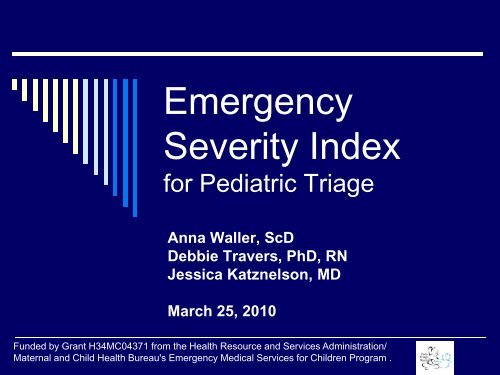

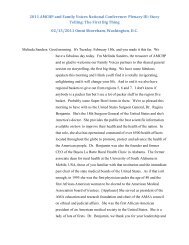



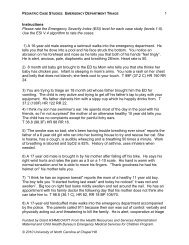
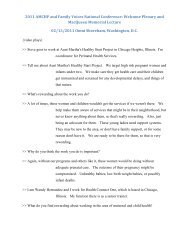
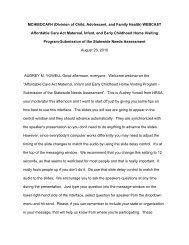
![Hormone Disruptors and Women's Health: Reasons for Concern [PDF]](https://img.yumpu.com/19410002/1/190x245/hormone-disruptors-and-womens-health-reasons-for-concern-pdf.jpg?quality=85)

